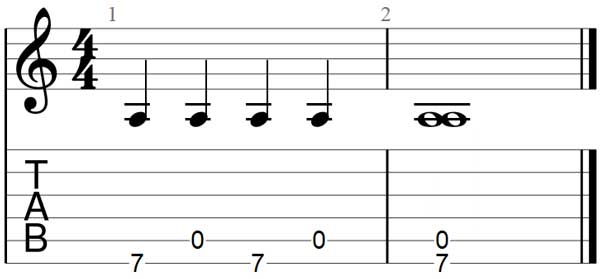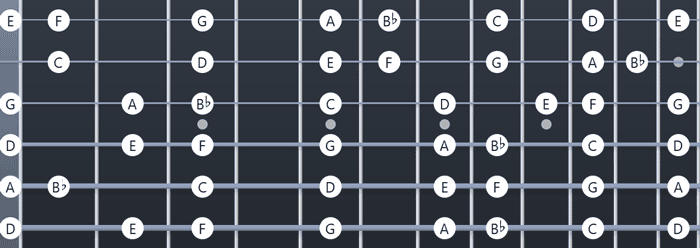Drop D tuning is the most popular alternate tuning for guitarists. If you’ve only played in standard tuning, you need to give Drop D a try.
Drop D is an easy alternate tuning to learn and gives you a good idea of why alternate tunings are so useful. While some guitarists will go through their entire lives never moving away from standard tuning, Drop D is a great example of how those guitarists are missing out.
In this guide, you will learn:
- How to tune your guitar in Drop D
- Great songs in Drop D tuning with Guitar TAB
- Easy chord shapes you can play in Drop D Tuning
- Scale diagrams for Drop D
Any guitar tuner can be used to tune your guitar in Drop D. If you don’t have a tuner, check out this guide on the Best Guitar Tuners to find one that suits you.
After you read through this guide, find out how to play in Drop D Tuning in this lesson. The lesson shows you how to play and write your own riffs in Drop D tuning.
How to Tune Your Guitar in Drop D
Tuning your guitar in Drop D is easy to do and easy to remember.
To tune your guitar in Drop D, tune your low E string down to D. All the other strings remain the same. You will end up with your guitar strings tuned to D A D G B E.
Here is a diagram showing what each string is tuned to in Drop D tuning:

The name ‘Drop D tuning’ comes from the simple idea that you ‘drop’ the tuning of your low E string down to D.
Drop D tuning is different than ‘D Standard’ or ‘D tuning’. In ‘D Standard’ tuning, you tune all six strings down the same amount so the strings end up as D G C F A D. D Standard tuning feels the same to play as standard tuning, while Drop D feels different to play.
How to tune your guitar in Drop D by ear
While it is always recommended you use a guitar tuner to tune your guitar (tuners are more accurate than our ears), you can tune to Drop D by ear.
There are two ways you can tune your guitar to Drop D by ear.
The first method is to compare the seventh fret on the sixth string to the open A string and tune the sixth string down until both notes match.

When you tune your low E string down far enough, the seventh fret will match the pitch of the open A string.
The second method is to play the open D string (fourth string) and tune the low E string down until you hear it resonate as an octave.

When you tune the low E string down far enough, you will hear that it suddenly starts to resonate clearly. With some practice, you can learn to quickly tune to Drop D just by listening to how the two strings resonate.
Drop D Tuning Chords
The great thing about Drop D is that most of the open chords you already know stay the same. Any chord you know from standard tuning that doesn’t use the low E string is exactly the same to play in Drop D.
Open Chords in Drop D Tuning
Here are some examples of chords that are the same to play in standard tuning and Drop D tuning:

If a chord uses the sixth string, it will be different in Drop D tuning. Here are some new chords to learn for Drop D tuning:

A lot of songs in Drop D focus on chords based on D, so it’s worth the effort to memorize these chords.
Power Chords in Drop D Tuning
One of the things that make Drop D Tuning so fun to play is how you play power chords.
Here is how you play power chords in Drop D Tuning:

Instead of using two (or three) fingers to play a power chord as you would in standard tuning, you only need to use one finger.
Power chords are played as normal on all other strings, but when they start on the sixth string, you only need one finger to play them.
As you will see in the Guitar TAB for songs later on, this lets you jump around the fretboard and play fast-moving power chords.
Metal and rock guitarists commonly use Drop D tuning (or lower tunings based on Drop D such as Drop C or Drop B) simply because of how different power chords feel to play.
Drop D Tuning Scales and Fretboard
If you have already memorized the notes on the fretboard in standard tuning (read this guide to learn how), you will find it easy to play scales in Drop D.
Here are the notes of the fretboard in Drop D Tuning:

This is easy to memorize because the top five strings are exactly the same as they are in standard tuning. So you should already know them.
The low D string is also easy to memorize because you should already know the note positions on the fourth string, which is also D.
If you already know the notes in standard tuning, you already know the notes in Drop D. All you need to do is get used to the sixth string being in D.
Here is the D minor scale in Drop D Tuning:

D minor is a popular scale when writing songs in Drop D Tuning because it makes great use of the open D string.
Metal and rock guitarist like to write in D minor (“D minor is the saddest of all keys”) and D minor works perfectly in Drop D.
If you’re looking for something a bit brighter, here are the notes to the D Major scale in Drop D Tuning:

The above fretboard diagram should make it clear that any scales you already know are easy to figure out in Drop D Tuning. All you need to do is replace the low E string with the notes you already know on the D string.
Drop D Tuning Songs
Drop D Tuning is the most popular alternate tuning and there are countless songs that use it. You can find songs written in Drop D tuning in so many different styles of music.
I’ve written an entire lesson showcasing some easy Drop D Songs, so check it out here to learn some easy riffs.
To find out about other tunings worth trying out, check out my Ultimate Guide to Alternate Tunings here. If you’ve only tried standard and drop tunings before, you might be surprised with how different some other tunings feel to play.
Find out how to play in Drop D Tuning in this lesson. The lesson shows you how to play and write your own riffs in Drop D tuning as well as how to use different power chord shapes to spice up your songwriting.
